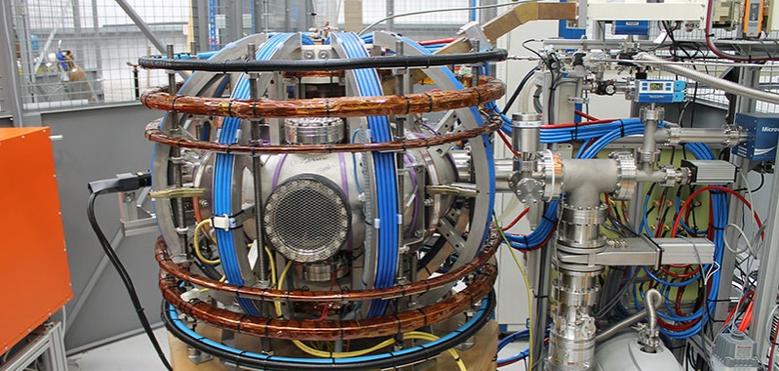
BRITAIN'S FUSION ENERGY

WNN - The UK Atomic Energy Authority (UKAEA) and First Light Fusion are collaborating on a project to convert fusion reactions into heat to enable clean power production. The 'fusion island' project is to be partly funded by a grant from the Department for Business, Energy & Industrial Strategy (BEIS).
First Light Fusion plans to demonstrate fusion by the middle of next year and to demonstrate 'gain' - generating more energy than that required to create fusion reactions - by 2024. No fusion energy project has achieved this yet. A key step in the development of First Light's vision is the creation of a fusion island, a sub-system that converts fusion energy into heat and manages fuel supply in a fusion power plant.
Thanks in part to an Energy Entrepreneurs Fund grant from BEIS, a fusion island concept development project is now under way. BEIS created the competitive funding scheme to support the development and demonstration of state-of-the-art technologies, products and processes in energy efficiency, power generation and heat and electricity storage.
Nick Hawker, founder and CEO of First Light Fusion, said: "We believe that the UK is one of the very best countries in the world in which to pursue our endeavour, powering a world worth inheriting. We are delighted that BEIS has recognised the quality, value and credibility of the work we have done so far."
Ian Chapman, CEO of UKAEA, said: "Fusion energy is an extraordinarily important area, and UKAEA is proud to be the home to world-leading expertise in the field. We are very pleased to be able to work with First Light Fusion and provide them with access to these capabilities for their exciting fusion programme."
In July, First Light Fusion successfully fired the first test 'shot' on one of the six limbs of its newly-constructed pulsed power machine and swiftly proceeded to test three-limb shots in September. The full machine is currently being commissioned, ahead of schedule. Once fully commissioned, Machine 3 will be the only pulsed power machine of its scale in the world dedicated to researching fusion energy. It can discharge up to 200,000 volts and more than 14 million amperes - the equivalent of nearly 500 simultaneous lightning strikes - within two microseconds. The GBP3.6 million (USD4.6 million) machine will use some 3 kilometres of high-voltage cables and another 10 kilometres of diagnostic cables.
Machine 3 will be used to further research First Light Fusion's technology as the company seeks to demonstrate first fusion next year.
First Light uses a high-velocity projectile to create a shockwave to collapse a cavity containing plasma inside a 'target'. The design of these targets is First Light's "technical USP", the company said.
First Light Fusion was founded by Professor Yiannis Ventikos, who is currently the head of the Mechanical Engineering Department at University College, London, and Dr Nicholas Hawker, formerly an engineering lecturer at Lady Margaret Hall, Oxford. The company was spun out from the University of Oxford in July 2011, with seed capital from IP Group plc, Parkwalk Advisors Ltd and private investors. Invesco and OSI provided follow-on capital.
UKAEA, a research organisation responsible for the development of nuclear, is an executive non-departmental public body of BEIS.
-----
Earlier:

2018, November, 14, 11:55:00
NUCLEAR NEEDS INVESTMENTWNN - world electricity generation increases from 25,679 TWh in 2017 to 30,253 TWh in 2025 and to 40,443 TWh in 2040. Global nuclear generation increases from 2637 TWh in 2017 to 3726 TWh in 2040, when it will account for around 9% of total electricity production, down from the current level of about 10.5%. Fossil fuels remain the major source for electricity generation under this scenario, but their share falls from around two-thirds today to under 50% by 2040.
|

2018, November, 12, 11:50:00
SMALL BRITAIN'S NUCLEARWNN - Advanced Nuclear Technologies - otherwise known as small nuclear or small reactor technologies - encompass a wide range of nuclear reactor technologies under development, BEIS noted. "The common attributes that these technologies share is that they are smaller than conventional nuclear power station reactors and are designed so that much of the plant can be fabricated in a factory environment and transported to site, reducing construction risk and making them less capital-intensive," it said.
|

2018, November, 5, 11:55:00
BRITAIN, CANADA NUCLEAR COOPERATIONWNN - The UK and Canada signed a bilateral Nuclear Cooperation Agreement (NCA), the third such agreement signed by the UK this year in preparation for its exit from the European Union. It will allow the UK and Canada to continue their "mutually beneficial" civil nuclear cooperation when current European Atomic Energy Community (Euratom) arrangements cease to apply in the UK, Department of Business, Energy and Industrial Strategy (BEIS) said.
|

2018, October, 3, 08:10:00
BRITISH NUCLEAR NEEDS £3.6 BLNTHE GUARDIAN - Backers of mini nuclear power stations have asked for billions of pounds of taxpayers’ money to build their first UK projects, according to an official document.
|

2018, September, 17, 14:50:00
U.S. & BRITAIN NUCLEAR RESEARCHWNN - The UK's National Nuclear Laboratory (NNL) and the US Department of Energy's Oak Ridge National Laboratory (ORNL) have agreed to cooperate on nuclear energy research. The announcement came as the UK and USA signed a nuclear R&D action plan.
|

2018, July, 27, 12:05:00
BRITAIN'S NUCLEAR POWER: 21%WNN - The Digest of UK Energy Statistics (DUKEs), published today by the Department for Business, Energy and Industrial Strategy (BEIS), shows low-carbon sources of electricity accounted for a record 50.1% of power generated in the UK in 2017, which is up from 45.6% the previous year. This figure consists of 21.0% from nuclear, 14.8% wind (onshore and offshore), 3.4% solar and 2.3% hydro amongst low-carbon power sources.
|

2018, March, 4, 10:55:00
BRITAIN'S NUCLEAR: 50%WNN - An experienced nuclear country like the UK should aim to have nuclear accounting for around 50% of its electricity mix, according to World Nuclear Association Director General Agneta Rising. |





